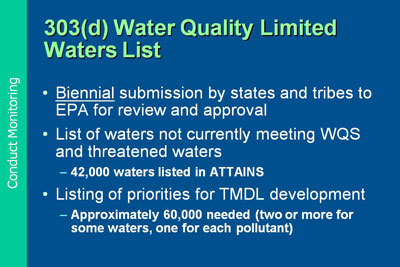303(d) Reports
The 303(d) list should include not only current water quality-limited water bodies but also waters believed to be threatened that are likely to become impaired for specific uses (i.e., not meeting WQS) by the time the next 303(d) list is due.
EPA regulations call for 303(d) lists to include only waters affected by “pollutants,” not those affected by other types of “pollution” (altered flow or channel modification). If it is certain that a water body’s poor condition is not caused by a “pollutant” but is due to another type of “pollution” such as flow, the water body does not need to be on the 303(d) list. If, however, biological monitoring indicates there is impairment of aquatic life uses, but it is not clear whether a pollutant is at least one of the reasons, the water should be on the 303(d) list, and further analysis to identify the causes are needed. Waters affected by “non-pollutant pollution” should be identified in category 4(c) of the Integrated Report.
EPA guidance documents mention numerous types of data and information that are considered “existing and readily available.” EPA has stated that such data include: (1) evidence of exceedance of a numeric WQC; (2) direct evidence of beneficial use impairment; (3) evidence that narrative standards are not being met; and (4) results of computer modeling of the water bodies. EPA also requires that data from sources other than the state agency itself—federal agencies, universities, volunteer monitoring groups—must be considered, and used, if they meet the state’s requirements for data quality. Some of the above actions might initially seem obvious, such as evidence of numeric WQC exceedances. But even this can be subject to debate. For instance, suppose you are dealing with a WQC expressed as a 30-day average concentration of pollutant “x,” and you have only two data points for the relevant 30-day period, each representing just one “grab sample.” Suppose both were higher (more polluted) than the WQC. Should this water be listed as “impaired,” or should more data be collected before putting the water on 303(d) list?
How would you measure impairment of a designated use directly? Using a biological assessment of aquatic life could be one method. Epidemiological studies showing a correlation between people swimming in the water and incidence of waterborne disease could be a direct measure of impairment of contact and recreation uses.
How should narrative WQC be interpreted? For example, how much “scum or floating debris” would constitute an exceedance? Would algal mats floating on a surface of the lake represent an exceedance of this narrative WQC, or perhaps of an “undesirable or nuisance aquatic life” narrative?
What if water quality computer modeling studies indicated that WQC would be exceeded at critical low flows, but actual monitoring data available from numerous samples from more typical flow conditions showed no exceedances of criteria. Should the water body be listed?
What level of training for volunteer monitors and what extent of quality assurance/quality control (QA/QC) measures should be required before data collected via volunteer monitoring efforts could be used as the basis of putting a water body on the 303(d) list?
The two most common causes of impairment, nutrients (nitrogen and phosphorus) and sediment, are parameters for which EPA and most states do not currently have numeric WQC. The sediment referred to here is clean sediment/silt, not toxics-laden bottom sediments. Nutrients are phosphorus and/or nitrogen. “Other habitat alterations” listed as sources of poor water quality means dams, channelization, bank destabilization, and removal of riparian vegetation, but usually not flow alteration. Organics refers to synthetic organics, not naturally occurring organic materials. Noxious aquatic plants includes blooms of blue-green algae and invasive species such as hydrilla.
![[logo] US EPA](https://www.epa.gov/epafiles/images/logo_epaseal.gif)
